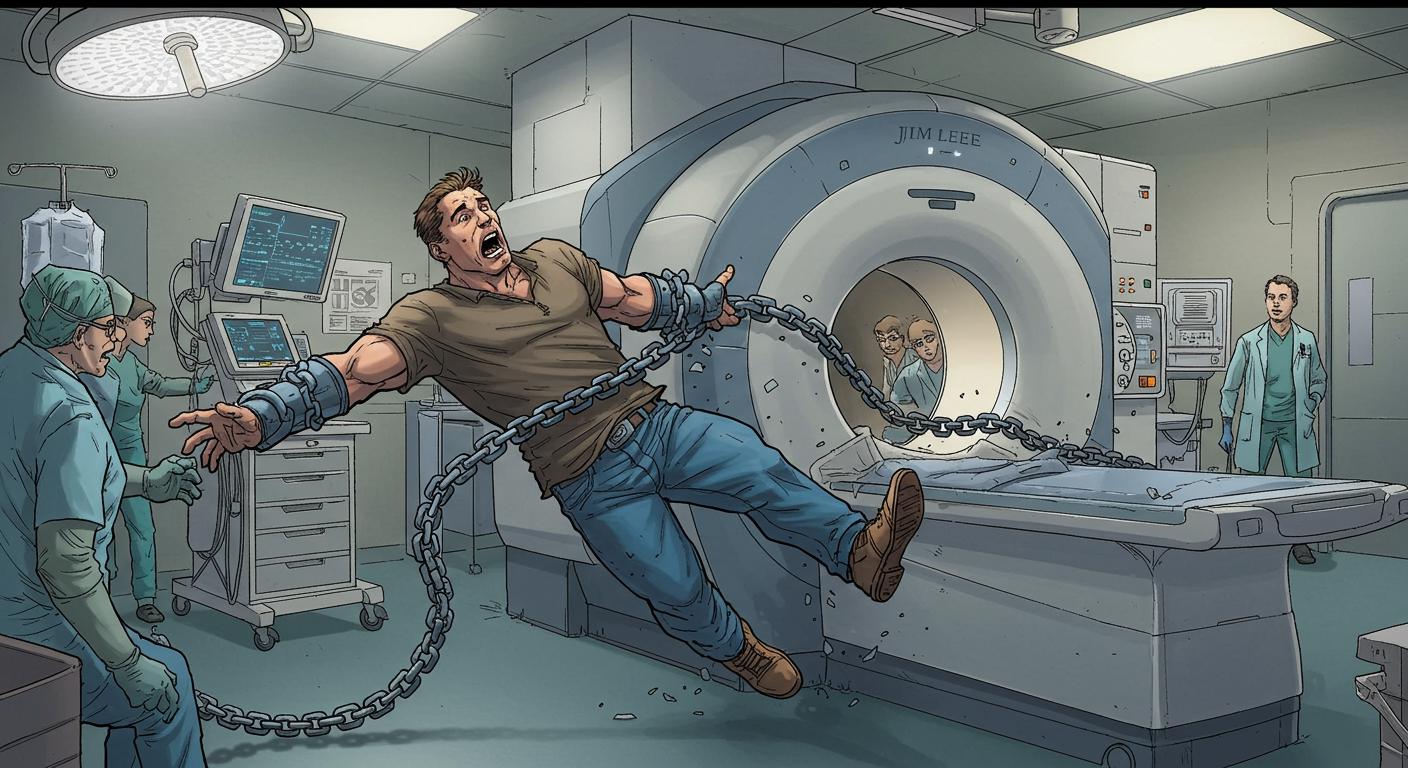Sometimes reality delivers a story so jarringly improbable that it edges into the realm of urban legend—except, in this case, the outcome was both grave and entirely preventable. This past week, a 61-year-old man died after being pulled into an MRI machine at Nassau Open MRI in Westbury, New York, while still wearing a large metal chain around his neck. According to ABC News, the incident unfolded on Wednesday afternoon, when the individual entered an unauthorized MRI room during an active scan. He suffered critical injuries and was pronounced dead the following day.
What Went Wrong?
Anyone who’s ever undergone an MRI scan is familiar with the ritualistic purging of all things metal—jewelry, keys, spare change, even stray bobby pins. MRI machines, as explained by Nassau County police and detailed in the WABC report, produce powerful magnetic fields capable of forcefully attracting metallic objects. In this case, the man—who, police and a facility employee told Newsday, was not a patient but rather at the clinic with someone else—entered the MRI room while a scan was in progress, wearing a “large metallic chain.” The magnetic force drew him into the machine, causing what police described as a “medical episode.”
Emergency physician Dr. Payal Sud, speaking to WABC about the event, remarked that strangulation, asphyxiation, or blunt force trauma were all potential outcomes given the situation—a grim menu of possibilities. As authorities summed it up for both ABC News and WABC, this was a tragic accident with no criminality suspected.
The Unlikelihood of MRI Fatalities
For further context, Newsday highlighted comments from Dr. Emanuel Kanal, founder of the American Board of Magnetic Resonance Safety and director at the University of Pittsburgh Medical Center. Dr. Kanal pointed out the extraordinary rarity of such events, stating fatalities involving projectiles drawn into MRI machines during scans have remained “in the single digits” globally since the technology’s introduction over forty years ago. He also referenced the infamous 2001 case in Westchester County, New York, where a flying oxygen tank caused the death of a child—a landmark event that catalyzed the creation of MRI Safety Week.
MRI machines use strong magnets and radio waves to generate images of tissue inside the body. The National Institute of Biomedical Imaging and Bioengineering, as cited in a roundup by NewsBreak, notes that objects of iron or certain steels can be “flung across the room” by an active magnet; medical staff at reputable facilities are trained to screen out even the smallest metallic items before a scan begins. The magnetic field strength of modern clinical MRI systems is such that, per technical background included in the same NewsBreak article, a 1.5 T magnet is around 21,000 times more powerful than the Earth’s natural field. While many of these scientific points are basic MRI knowledge, it’s critical that they translate into unbreakable procedural habits on the ground.
Given these layers of protocol, one can only speculate how such a breach occurred. WABC notes that the entry into the suite was unauthorized, and local police said the victim “was not a patient.” The question looms: how did someone manage to pass from a waiting area into a live MRI suite, undiscovered, with a prominent metallic object?
Room for (Painful) Reflection
A glance through reader comments on platforms like NewsBreak exposes more questions (and, inevitably, more heat than light). Many ask about staffing or signage—why the MRI zone was apparently accessible, and why attendants weren’t immediately present to intervene. Others debate whether blame sits primarily with facility staff, or the individual who entered. Some correctly clarify details for confused readers, pointing out that, as the initial police reports summarized by NewsBreak and others make clear, the victim was neither a patient in the scanner, nor scheduled for a scan that day. Still, with protocol—a word found repeatedly in medical safety manuals—meant to stop precisely this type of accident, the conversation seems to circle the uncomfortable prospect of routine lapses compounding.
If this event proves anything, it’s that the boundaries and locked doors of MRI suites aren’t just healthcare bureaucracy, but serve as the thin barrier between professional routine and dangerous potential. As recounted by Newsday, MRI safety procedures have evolved specifically to avoid incidents like this, and the physical forces involved aren’t merely theoretical.
Looking Forward
The incident, as ABC News reports, remains under active investigation by local authorities and, presumably, relevant health agencies. Nassau Open MRI has declined to comment. Whether this case sets off a wave of safety audits, renewed signage, or the installation of stricter physical barriers remains to be seen.
It seems unlikely that the man at Nassau Open MRI imagined that a chain necklace—a fashion accessory, nothing more—could so quickly endanger his life. As Dr. Kanal told Newsday, every rare MRI accident adds a chapter to the annals of medical safety. One has to wonder: will this case prompt a fresh commitment to upholding that “unbreakable” chain of protocol in the MRI suite? Or, like so many cautionary tales, will it simply fade into the archives, retold only in training sessions and, on occasion, in small corners of the curious internet?
Strange and tragic stories sometimes serve a medicinal purpose: they snap us out of complacency, for a while. Whether that snap endures—well, that remains to be seen.







